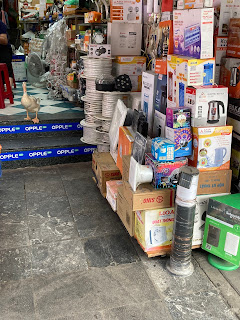November 23rd, 2024
The Hoa Lo
Prison was constructed in the late 1800s by the French colonists in Indochina to
house political prisoners. Later it was
used to imprison US POWs (primarily aviators) in the Vietnam War. The name “Hoa Lo” means “fiery furnace” or “Hell’s
hole”. Sounds lovely doesn’t it? A lot of the prison was demolished in the 1990s
to make way for some high-rise apartments, but what was left has now been
turned into a museum.
I'm ready to go for the audio tour...I'm smirking as I sent this to Naomi as she getting her hair done, and she hates audio tours.
The audio
tour started in the “Maison Centrale”, which is French for Central House. This is where the dangerous and long sentence
detainees were kept. Two long platforms
lined the long sides of the rectangular room which served as the beds for the prisoners. At the inner side of the platform were iron shackles
for the legs of the prisoners and at one end were two very rudimentary toilets. It was definitely not a pleasant place to be.
The number
of convicts in the prison rose from 460 in 1913 to over 2000 in 1954. The inmates were held in subhuman conditions
to say the least. When the Democratic
Republic of Vietnam was founded in 1954, the prison was converted to an
education center for revolutionary doctrine and kept as a reminder as to the incredible
sacrifice the political prisoners had made and the terrible mark the French had
left on this country.
With the
outbreak of the Vietnam War, American prisoners of war were incarcerated at the
prison, which was later dubbed the “Hanoi Hilton” by its occupants. The first prisoner arrived in 1964 and the jail
was in use until the end of the war.
I found it
interesting that the Vietnam War exhibition section really tried hard to paint
a picture that the prisoners were treated very humanely. They were well fed, allowed to play games
like checkers, chess and cards, exercise regularly and were never treated badly. Well, if you do some research, that doesn’t
quite seem to be the case. A famous incident
was when POW Jeremiah
Denton was on a televised press conference which he was forced to
participate in by his captors to state to the World how well he was being
treated. Feigning that he was having
trouble with the bright television lights, he blinked T-O-R-T-U-R-E in Morse
code.
All in all, it was quite an interesting museum.





















hey hey stay away from those places haha .yah know India haha enjoy pal
ReplyDelete